SLOS913A October 2015 – February 2017 SN55HVD75-EP
PRODUCTION DATA.
- 1 Features
- 2 Applications
- 3 Description
- 4 Revision History
- 5 Pin Configuration and Functions
- 6 Specifications
- 7 Parameter Measurement Information
- 8 Detailed Description
- 9 Application and Implementation
- 10Power Supply Recommendations
- 11Layout
- 12Device and Documentation Support
- 13Mechanical, Packaging, and Orderable Information
Package Options
Mechanical Data (Package|Pins)
- DRB|8
Thermal pad, mechanical data (Package|Pins)
- DRB|8
Orderable Information
6 Specifications
6.1 Absolute Maximum Ratings
over recommended operating range (unless otherwise specified) (1)| MIN | MAX | UNIT | |
|---|---|---|---|
| Supply voltage, VCC | –0.5 | 5.5 | V |
| Voltage at A or B inputs | –13 | 16.5 | V |
| Input voltage at any logic pin | –0.3 | 5.7 | V |
| Voltage input, transient pulse, A and B, through 100 Ω | –100 | 100 | V |
| Receiver output current | –24 | 24 | mA |
| Junction temperature, TJ | 170 | °C | |
| Storage temperature, Tstg | –65 | 150 | °C |
(1) Stresses beyond those listed under Absolute Maximum Ratings may cause permanent damage to the device. These are stress ratings only and functional operation of the device at these or any other conditions beyond those indicated under Recommended Operating Conditions is not implied. Exposure to absolute-maximum-rated conditions for extended periods may affect device reliability.
6.2 ESD Ratings
| VALUE | UNIT | ||||
|---|---|---|---|---|---|
| V(ESD) | Electrostatic discharge | Human-body model (HBM), per ANSI/ESDA/JEDEC JS-001 (1) | All pins | ±8000 | V |
| Charged-device model (CDM), per JEDEC specification JESD22-C101(2) | All pins | ±1500 | |||
| JEDEC standard 22, test method A115 (machine model) | All pins | ±300 | |||
| IEC 61000-4-2 ESD (air-gap discharge)(3) | Pins 5 to 7 | ±12000 | |||
| IEC 61000-4-2 ESD (contact discharge) | Pins 5 to 7 | ±12000 | |||
| IEC 61000-4-4 EFT (fast transient or burst) | Pins 5 to 7 | ±4000 | |||
| IEC 60749-26 ESD HBM | Pins 5 to 7 | ±15000 | |||
(1) JEDEC document JEP155 states that 500-V HBM allows safe manufacturing with a standard ESD control process.
(2) JEDEC document JEP157 states that 250-V CDM allows safe manufacturing with a standard ESD control process.
(3) By inference from contact discharge results, see Application and Implementation.
6.3 Recommended Operating Conditions
| MIN | NOM | MAX | UNIT | |||
|---|---|---|---|---|---|---|
| VCC | Supply voltage | 3 | 3.3 | 3.6 | V | |
| VI | Input voltage at any bus terminal (separately or common mode)(1) | –7 | 12 | V | ||
| VIH | High-level input voltage (driver, driver enable, and receiver enable inputs) | 2 | VCC | V | ||
| VIL | Low-level input voltage (driver, driver enable, and receiver enable inputs) | 0 | 0.8 | V | ||
| VID | Differential input voltage | –12 | 12 | V | ||
| IO | Output current, driver | –60 | 60 | mA | ||
| IO | Output current, receiver | –8 | 8 | mA | ||
| RL | Differential load resistance | 54 | 60 | Ω | ||
| CL | Differential load capacitance | 50 | pF | |||
| 1/tUI | Signaling rate | 20 | Mbps | |||
| TA(2) | Operating free-air temperature (see Thermal Information) | –55 | 125 | °C | ||
| TJ | Junction temperature | –55 | 150 | °C | ||
(1) The algebraic convention, in which the least positive (most negative) limit is designated as minimum, is used in this data sheet.
(2) Operation is specified for internal (junction) temperatures up to 150°C. Self-heating due to internal power dissipation should be considered for each application. Maximum junction temperature is internally limited by the thermal shutdown (TSD) circuit which disables the driver outputs when the junction temperature reaches 170°C.
6.4 Thermal Information
| THERMAL METRIC(1) | SN55HVD75-EP | UNIT | |
|---|---|---|---|
| DRB (VSON) | |||
| 8 PINS | |||
| RθJA | Junction-to-ambient thermal resistance | 40.0 | °C/W |
| RθJC(top) | Junction-to-case (top) thermal resistance | 49.6 | °C/W |
| RθJC(bot) | Junction-to-case (bottom) thermal resistance | 3.9 | °C/W |
| RθJB | Junction-to-board thermal resistance | 15.5 | °C/W |
| ψJT | Junction-to-top characterization parameter | 0.6 | °C/W |
| ψJB | Junction-to-board characterization parameter | 15.7 | °C/W |
(1) For more information about traditional and new thermal metrics, see the Semiconductor and IC Package Thermal Metrics application report, SPRA953.
6.5 Electrical Characteristics
over recommended operating range (unless otherwise specified)| PARAMETER | TEST CONDITIONS | MIN | TYP | MAX | UNIT | |||
|---|---|---|---|---|---|---|---|---|
| |VOD| | Driver differential output voltage magnitude | RL = 60 Ω, 375 Ω on each output to –7 V to 12 V |
See Figure 6 | 1.5 | 2 | V | ||
| RL = 54 Ω (RS-485) | See Figure 7 | 1.5 | 2 | |||||
| RL = 100 Ω | 1.8 | 2.5 | ||||||
| Δ|VOD| | Change in magnitude of driver differential output voltage | RL = 54 Ω, CL = 50 pF | –50 | 0 | 50 | mV | ||
| VOC(SS) | Steady-state common-mode output voltage | Center of two 27-Ω load resistors | 1 | VCC/2 | 3 | V | ||
| ΔVOC | Change in differential driver output common-mode voltage | –50 | 0 | 50 | mV | |||
| VOC(PP) | Peak-to-peak driver common-mode output voltage | 200 | mV | |||||
| COD | Differential output capacitance | 15 | pF | |||||
| VIT+ | Positive-going receiver differential input voltage threshold | See (1) | –70 | –20 | mV | |||
| VIT– | Negative-going receiver differential input voltage threshold | –200 | –150 | See (1) | mV | |||
| VHYS | Receiver differential input voltage threshold hysteresis (VIT+ – VIT–) | 50 | 80 | mV | ||||
| VOH | Receiver high-level output voltage | IOH = –8 mA | 2.4 | VCC – 0.3 | V | |||
| VOL | Receiver low-level output voltage | IOL = 8 mA | 0.2 | 0.4 | V | |||
| II | Driver input, driver enable, and receiver enable input current | –2.75 | 2.75 | µA | ||||
| IOZ | Receiver output high-impedance current | VO = 0 V or VCC, RE at VCC | –1 | 1 | µA | |||
| IOS | Driver short-circuit output current | –165 | 165 | mA | ||||
| II | Bus input current (disabled driver) | VCC = 3 V to 3.6 V or VCC = 0 V DE at 0 V |
VI = 12 V | 75 | 150 | µA | ||
| VI = –7 V | –100 | –40 | ||||||
| ICC | Supply current (quiescent) | Driver and receiver enabled | DE = VCC, RE = GND No load |
750 | 950 | µA | ||
| Driver enabled, receiver disabled | DE = VCC, RE = VCC
No load |
300 | 500 | |||||
| Driver disabled, receiver enabled | DE = GND, RE = GND No load |
600 | 800 | |||||
| Driver and receiver disabled | DE = GND, D = open RE = VCC, No load |
0.1 | 2 | |||||
| Supply current (dynamic) | See Typical Characteristics | |||||||
(1) Under any specific conditions, VIT+ is assured to be at least VHYS higher than VIT–.
6.6 Switching Characteristics: 20 Mbps Device, Bit Time ≥50 ns
over recommended operating conditions| PARAMETER | TEST CONDITIONS | MIN | TYP | MAX | UNIT | ||
|---|---|---|---|---|---|---|---|
| DRIVER | |||||||
| tr, tf | Driver differential output rise or fall time | RL = 54 Ω CL = 50 pF |
See Figure 8 | 1 | 7 | 14 | ns |
| tPHL, tPLH | Driver propagation delay | 6 | 11 | 17 | ns | ||
| tSK(P) | Driver pulse skew, |tPHL – tPLH| | 0 | 2 | ns | |||
| tPHZ, tPLZ | Driver disable time | See Figure 9 and Figure 10 | 12 | 50 | ns | ||
| tPZH, tPZL | Driver enable time | Receiver enabled | 10 | 20 | ns | ||
| Receiver disabled | 3 | 7 | µs | ||||
| RECEIVER | |||||||
| tr, tf | Receiver output rise or fall time | CL = 15 pF | See Figure 11 | 5 | 10 | ns | |
| tPHL, tPLH | Receiver propagation delay time | 60 | 70 | ns | |||
| tSK(P) | Receiver pulse skew, |tPHL – tPLH| | 0 | 6 | ns | |||
| tPLZ, tPHZ | Receiver disable time | 15 | 30 | ns | |||
| tpZL(1), tPZH(1), tPZL(2), tPZH(2) | Receiver enable time | Driver enabled | See Figure 12 | 10 | 50 | ns | |
| Driver disabled | See Figure 13 | 3 | 8 | µs | |||
6.7 Typical Characteristics
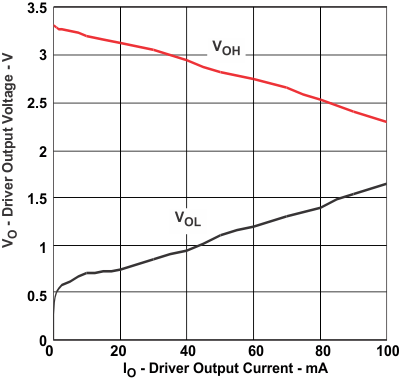
| VCC = 3.3 V | DE = VCC | D = 0 V |
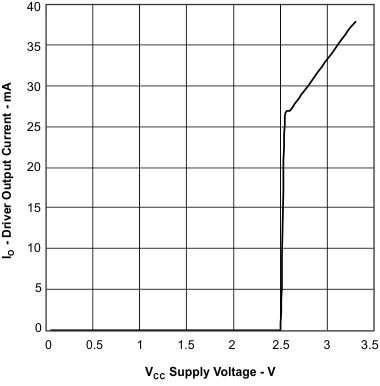
| TA = 25°C | RL = 54 Ω | D = VCC |
| DE = VCC |
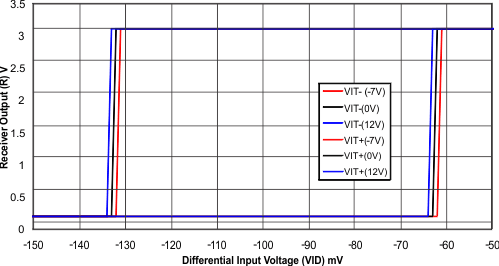
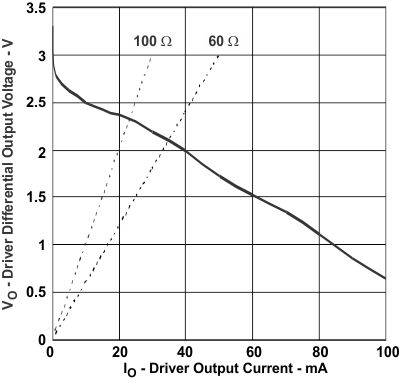
| VCC = 3.3 V | DE = VCC | D = 0 V |
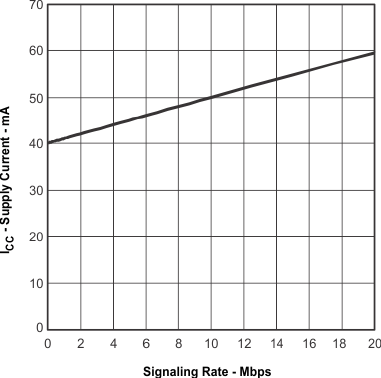
| RL = 54 Ω | ||